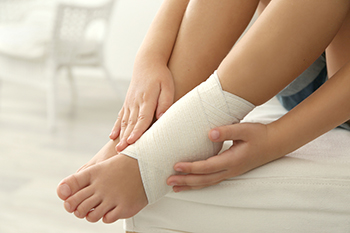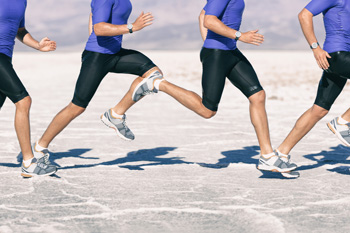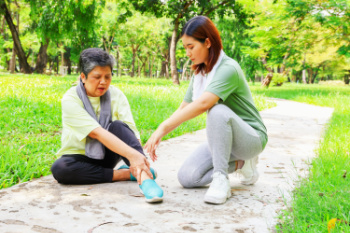Connect With Us
Blog

Ankle sprains happen often, especially during sports, exercise, or even from simply stepping the wrong way. They occur when the ligaments surrounding the ankle stretch or tear, usually from the foot turning inward. While many people heal with rest and care, some do not fully recover. This can lead to a long-term issue called chronic ankle instability, where the ankle feels weak, wobbly, or keeps giving out. People who have had more than one sprain are more likely to develop this ongoing problem. It can affect balance, movement, and increase the risk of future injuries. Strengthening the ankle, wearing the right shoes, and early treatment can help prevent long-term damage. If you have had repeated ankle sprains or still feel unsteady, it is suggested that you see a podiatrist for appropriate treatment.
Ankle sprains are common but need immediate attention. If you need your feet checked, contact Daniel Bell, DPM from Florida. Our doctor can provide the care you need to keep you pain-free and on your feet.
How Does an Ankle Sprain Occur?
Ankle sprains take place when the ligaments in your ankle are torn or stretched beyond their limits. There are multiple ways that the ankle can become injured, including twisting or rolling over onto your ankle, putting undue stress on it, or causing trauma to the ankle itself.
What Are the Symptoms?
- Mild to moderate bruising
- Limited mobility
- Swelling
- Discoloration of the skin (depending on severity)
Preventing a Sprain
- Wearing appropriate shoes for the occasion
- Stretching before exercises and sports
- Knowing your limits
Treatment of a Sprain
Treatment of a sprain depends on the severity. Many times, people are told to rest and remain off their feet completely, while others are given an air cast. If the sprain is very severe, surgery may be required.
If you have suffered an ankle sprain previously, you may want to consider additional support such as a brace and regular exercises to strengthen the ankle.
If you have any questions please feel free to contact our office located in Pembroke Pines and Plantation, FL . We offer the newest diagnostic and treatment technologies for all your foot and ankle needs.

The feet play a vital role in athletic performance by providing shock absorption, stability, and propulsion. They absorb impact forces during activities such as running and jumping, reducing stress on the joints and muscles. Proper foot alignment enhances stability, allowing athletes to maintain balance and control movement efficiently. The way the feet strike the ground affects energy transfer and can influence speed and endurance. A strong push-off from the toes generates power for sprinting, jumping, and sudden changes in direction. Foot mechanics also determine how effectively an athlete can pivot and accelerate. Strengthening the muscles of the feet and wearing appropriate footwear can enhance performance and reduce injury risk. If you participate in sporting activities and have injured your foot or ankle, it is suggested that you contact a podiatrist who can treat various foot conditions, and offer effective injury prevention methods.
If you have any concerns about your feet, contact Daniel Bell, DPM from Florida. Our doctor can provide the care you need to keep you pain-free and on your feet.
Biomechanics in Podiatry
Podiatric biomechanics is a particular sector of specialty podiatry with licensed practitioners who are trained to diagnose and treat conditions affecting the foot, ankle and lower leg. Biomechanics deals with the forces that act against the body, causing an interference with the biological structures. It focuses on the movement of the ankle, the foot and the forces that interact with them.
A History of Biomechanics
- Biomechanics dates back to the BC era in Egypt where evidence of professional foot care has been recorded.
- In 1974, biomechanics gained a higher profile from the studies of Merton Root, who claimed that by changing or controlling the forces between the ankle and the foot, corrections or conditions could be implemented to gain strength and coordination in the area.
Modern technological improvements are based on past theories and therapeutic processes that provide a better understanding of podiatric concepts for biomechanics. Computers can provide accurate information about the forces and patterns of the feet and lower legs.
Understanding biomechanics of the feet can help improve and eliminate pain, stopping further stress to the foot.
If you have any questions please feel free to contact our office located in Pembroke Pines and Plantation, FL . We offer the newest diagnostic and treatment technologies for all your foot and ankle needs.

Ankle pain while walking can result from several conditions that affect the joint, tendons, or ligaments. Ankle sprains occur when ligaments stretch or tear due to an awkward twist or misstep. Gout can cause inflammation in the ankle joint due to crystal deposits in the joint that lead to pain and swelling. Osteoarthritis, which develops when the protective cartilage wears down, causes stiffness and discomfort. Rheumatoid arthritis triggers chronic inflammation that can affect ankle joint function. Impingement syndrome results from nerve or tendon compression and is often seen in people who engage in repetitive movements. Additionally, tendinitis, which occurs due to overuse, leads to irritation and inflammation of the ankle tendons, making walking difficult. A podiatrist can determine the cause of your ankle pain and determine whether supportive devices, medication, or surgery is needed. If you experience foot pain during or after walking, it is suggested that you schedule an appointment with a podiatrist for an exam, diagnosis, and appropriate treatment.
Ankle pain can have many different causes and the pain may potentially be serious. If you have ankle pain, consult with Daniel Bell, DPM from Florida. Our doctor will assess your condition and provide you with quality foot and ankle treatment.
Ankle pain is any condition that causes pain in the ankle. Due to the fact that the ankle consists of tendons, muscles, bones, and ligaments, ankle pain can come from a number of different conditions.
Causes
The most common causes of ankle pain include:
- Types of arthritis (rheumatoid, osteoarthritis, and gout)
- Ankle sprains
- Broken ankles
- Achilles tendinitis
- Achilles tendon rupture
- Stress fractures
- Tarsal tunnel syndrome
- Plantar fasciitis
Symptoms
Symptoms of ankle injury vary based upon the condition. Pain may include general pain and discomfort, swelling, aching, redness, bruising, burning or stabbing sensations, and/or loss of sensation.
Diagnosis
Due to the wide variety of potential causes of ankle pain, podiatrists will utilize a number of different methods to properly diagnose ankle pain. This can include asking for personal and family medical histories and of any recent injuries. Further diagnosis may include sensation tests, a physical examination, and potentially x-rays or other imaging tests.
Treatment
Just as the range of causes varies widely, so do treatments. Some more common treatments are rest, ice packs, keeping pressure off the foot, orthotics and braces, medication for inflammation and pain, and surgery.
If you have any questions, please feel free to contact our office located in Pembroke Pines and Plantation, FL . We offer the newest diagnostic and treatment technologies for all your foot care needs.
Blog Archives
- April 2025
- March 2025
- February 2025
- January 2025
- December 2024
- November 2024
- October 2024
- September 2024
- August 2024
- July 2024
- June 2024
- May 2024
- April 2024
- March 2024
- February 2024
- January 2024
- December 2023
- November 2023
- October 2023
- September 2023
- August 2023
- July 2023
- June 2023
- May 2023
- April 2023
- March 2023
- February 2023
- January 2023
- December 2022
- November 2022
- October 2022
- September 2022
- August 2022
- July 2022
- June 2022
- May 2022
- April 2022
- March 2022
- February 2022
- January 2022
- December 2021
- November 2021

